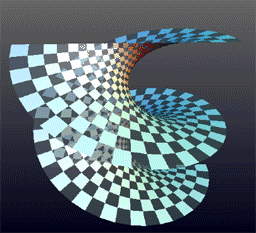I'm trying to find a function $f(x)$ such that the two surfaces given below are isometric:
$$f_1(x,y) = (ax \cos(y), ax \sin(y), y)$$
$$f_2(x,y) = (f(x)\cos(y), f(x)\sin(y), x)$$
Now I understand that two parametrisation patches of a surface are isometric iff they have the same first fundamental form.
I can calculate the first fundamental form of the first surface to be:
$$I_1 = a^2 dx^2 + (1+a^2 x^2)dy^2$$
and the second:
$$I_2 = ((f'(x))^2+1)dx^2 + f(x)^2 dy^2$$
Now I'm not sure what I'm missing here because surely then we must have $f(x) = (1+a^2 x^2)^{1/2}$ from the $dy$ but that is then inconsistent with the condition on the $dx^2$ term.
Is there some other way to deal with this? Have I misunderstood conceptually what it means to be isometric?
Thanks

Best Answer
It's pretty much a classical result that the catenoid and helicoid are isometric; if you look up a proof of that, you'll probably be able to discover the inconsistency in your reasoning.
One thought: there's no reason that the isometry has to take $x$ to $x$ and $y$ to $y$ in your chosen parameterizations, so your reasoning about the coefficients of dx and dy seems invalid. Although as I recall, in the standard catenoid-to-helicoid isometry, the radial coordinate on the helicoid ($x$) corresponds to the axial coordinate ($x$) on the helicoid, so maybe you're OK.
BTW, the function, for the catenoid, is $e^x + e^{-x}$; you may need some constants in there to make things work out.
BTW 2: there's an animation of the helicoid to catenoid isometry on the Wikipedia page for catenoids
More Detail The problem is that an isometry is a map between surfaces that preserves fundamental forms. If you reparameterize the first surface, you have to reparameterize the second "in the same way" to still preserve the forms. But before you can do that, you need to find SOME isometry between SOME pair of parameterizations, and just picking two and hoping doesn't usually work. :(
Following the Wikipedia page, I find that two workable parameterizations are \begin{align} S_1(u, v) &= (\sinh v \,\sin u , \sinh v \,\cos u , u) \\ S_2(u, v) &= (\cosh v \,\cos u , \cosh v \,\sin u , v) \\ \end{align}
In your case, in the first parameterization, you have $x = \sinh v$, and in the second, $f(x) = \cosh v$. Since $\cosh^2 x = 1 + \sinh^2 x$, you have $f(x) = \sqrt{1 + x^2}$, just as you conjectured.
But the actual isometry from $S_2$ to $S_1$ is the map $(x, y) \mapsto (\sinh x, y)$.
So you need to compare the 1st fundamental form for $S_2$ at $(x, y)$ to the first fundamental form for $S_1$ at the point $(\sinh x, y)$. If you try that, things might work out.